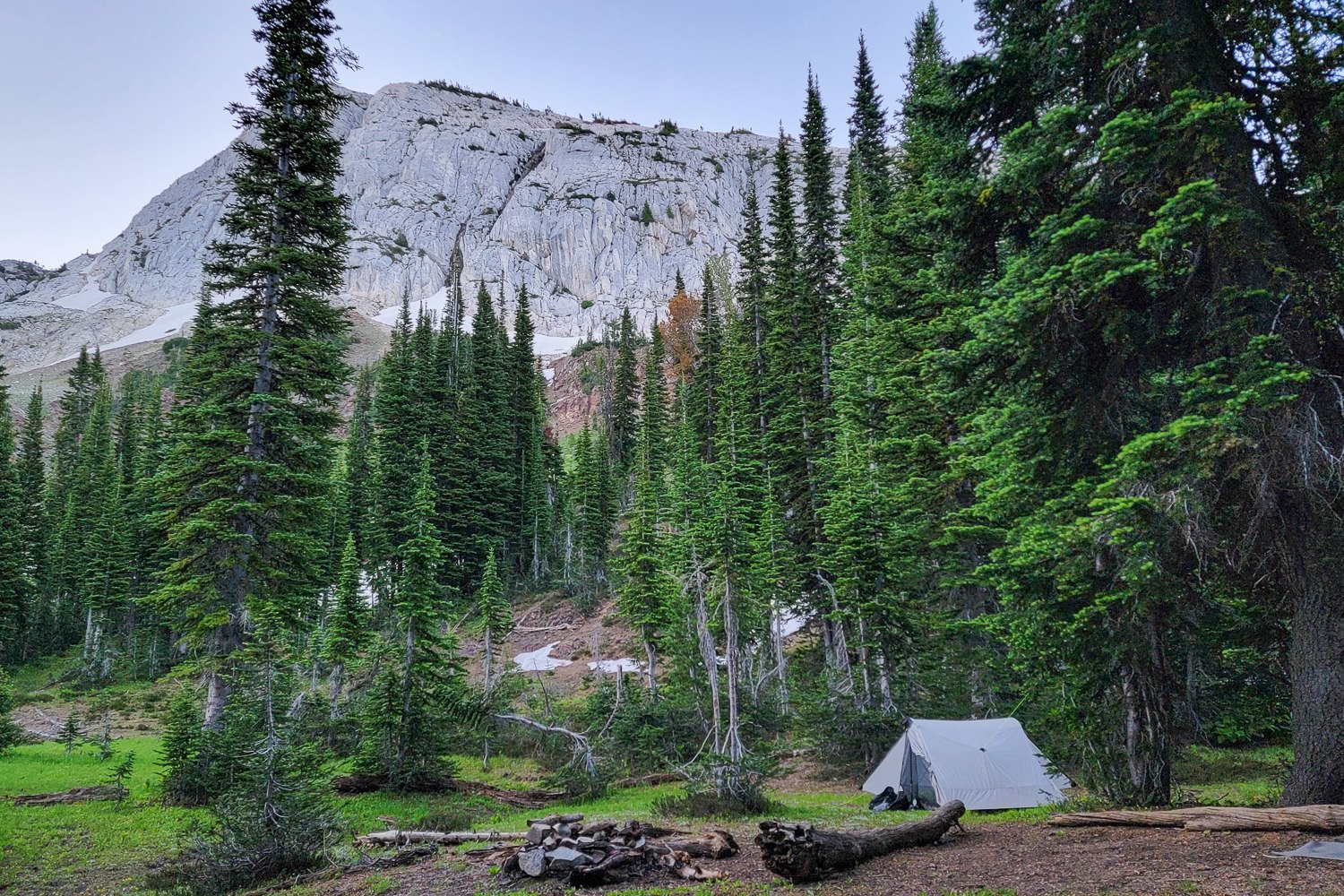Your backpacking tent will be one of the most important gear purchases you make. Finding one that has the best balance of weight, interior space, convenience, and weather protection will make it much easier to stay happy and comfortable on trail.
There are tons of backpacking tents to sift through, so It can easily become overwhelming to delve into such a big decision. Our team of gear experts has tested dozens of tents on trails all over the world – from the alpine peaks of Patagonia to summer monsoons in the Rockies. We’ll use our experience in this guide to help you find the best backpacking tent to fit your needs.
Quick Recommendations
Check out this quick list of the best backpacking tents, or continue scrolling to see our full list of favorites with in-depth reviews.
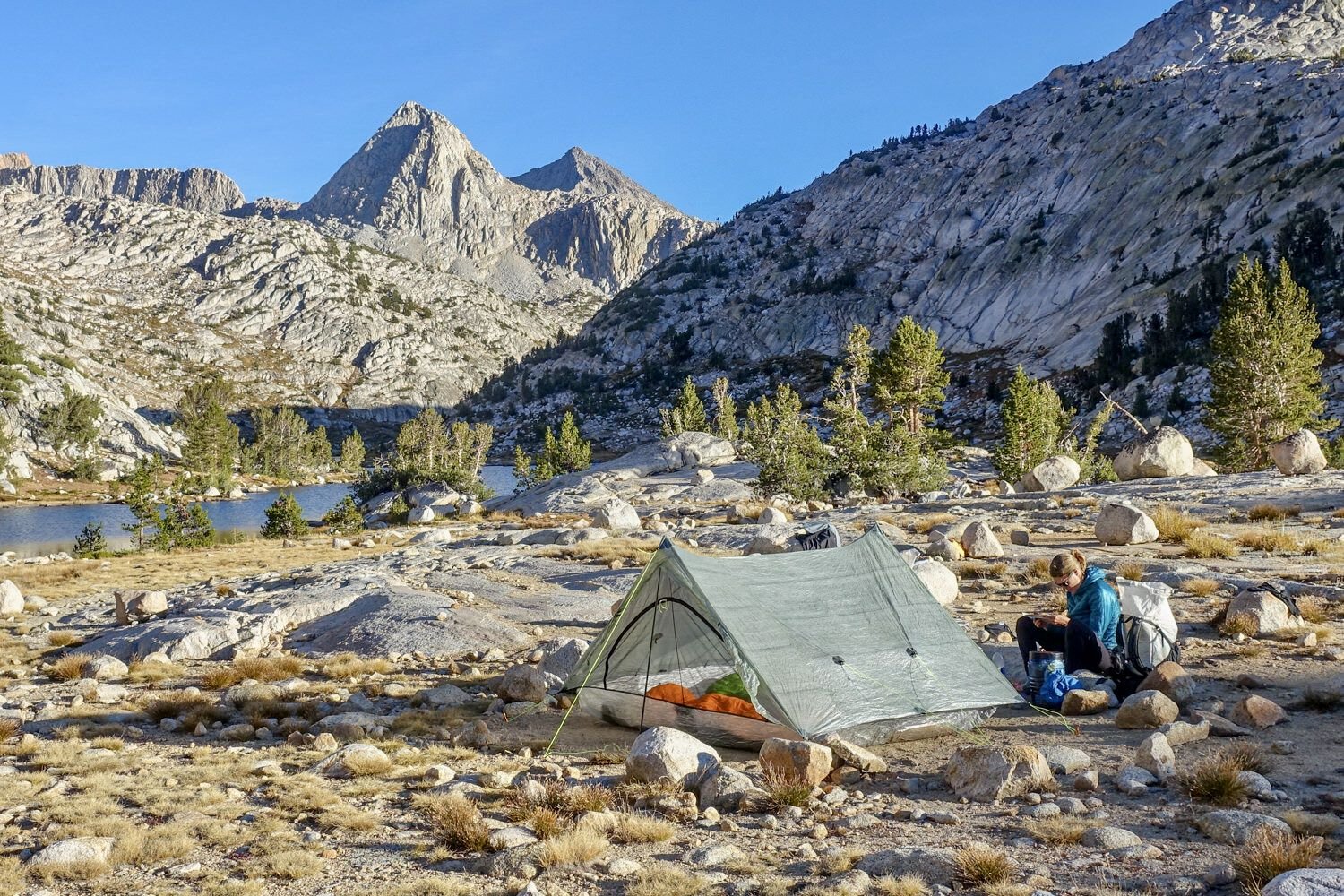
What’s New:
We put the leading semi-freestanding tents through more head-to-head testing, and added our favorites. The Big Agnes Tiger Wall 2 came out on top as our number one semi-freestanding pick due to its low weight and good headroom. The NEMO Hornet OSMO 3 was also added for hikers looking for a balance between weight and interior space.
Backpacking Tent Comparison Table
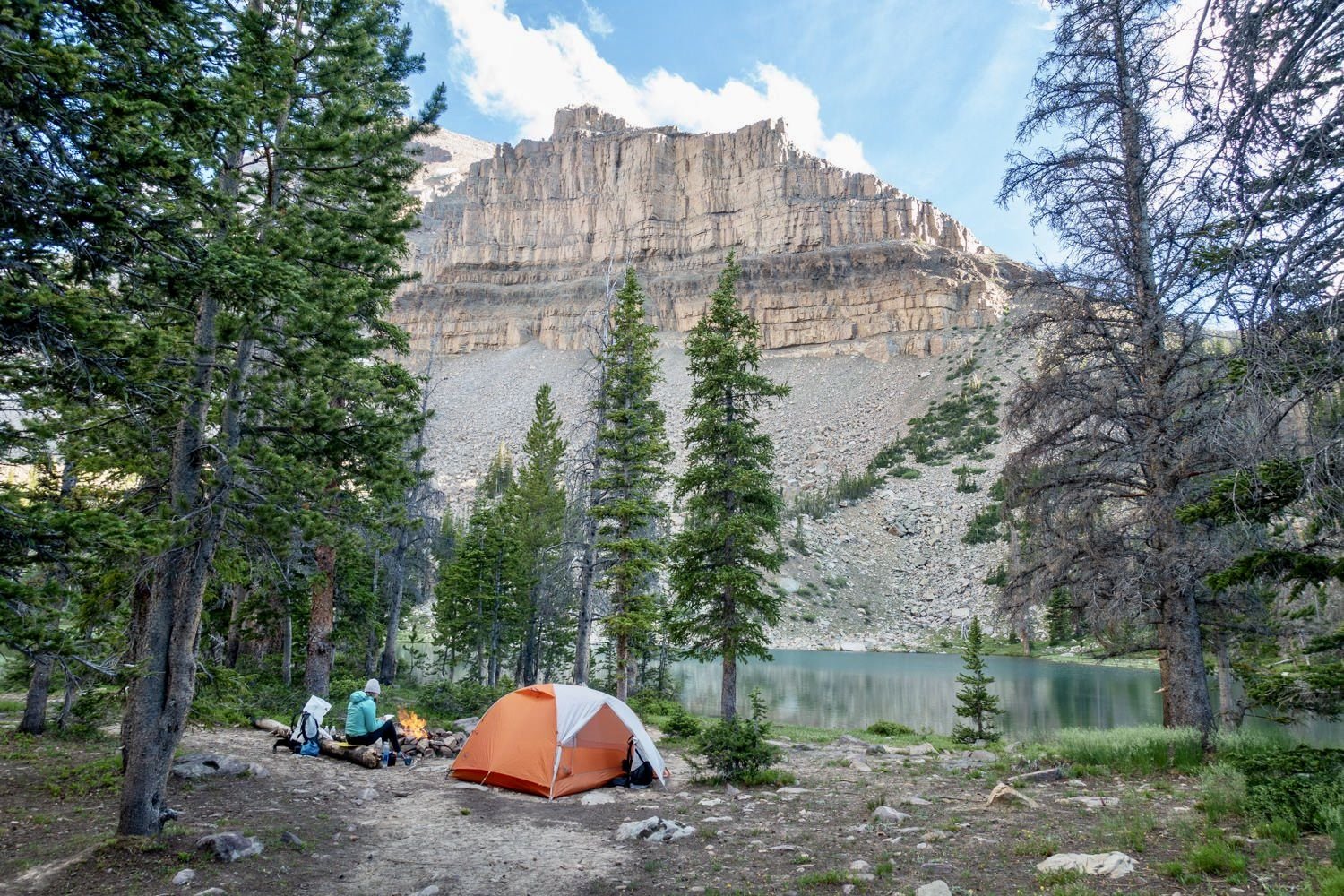
What’s Most Important to You in a Backpacking Tent?
WEIGHT:
Your backpacking tent will be one of the four heaviest items in your pack – tent, backpack, sleeping bag, sleeping pad – so this is a great place to save weight. We consider weight one of the most important specs for backpacking gear. The lighter your backpack, the more comfortable it will be, the more miles you’ll be able to hike, and the more enjoyable your trip will be.
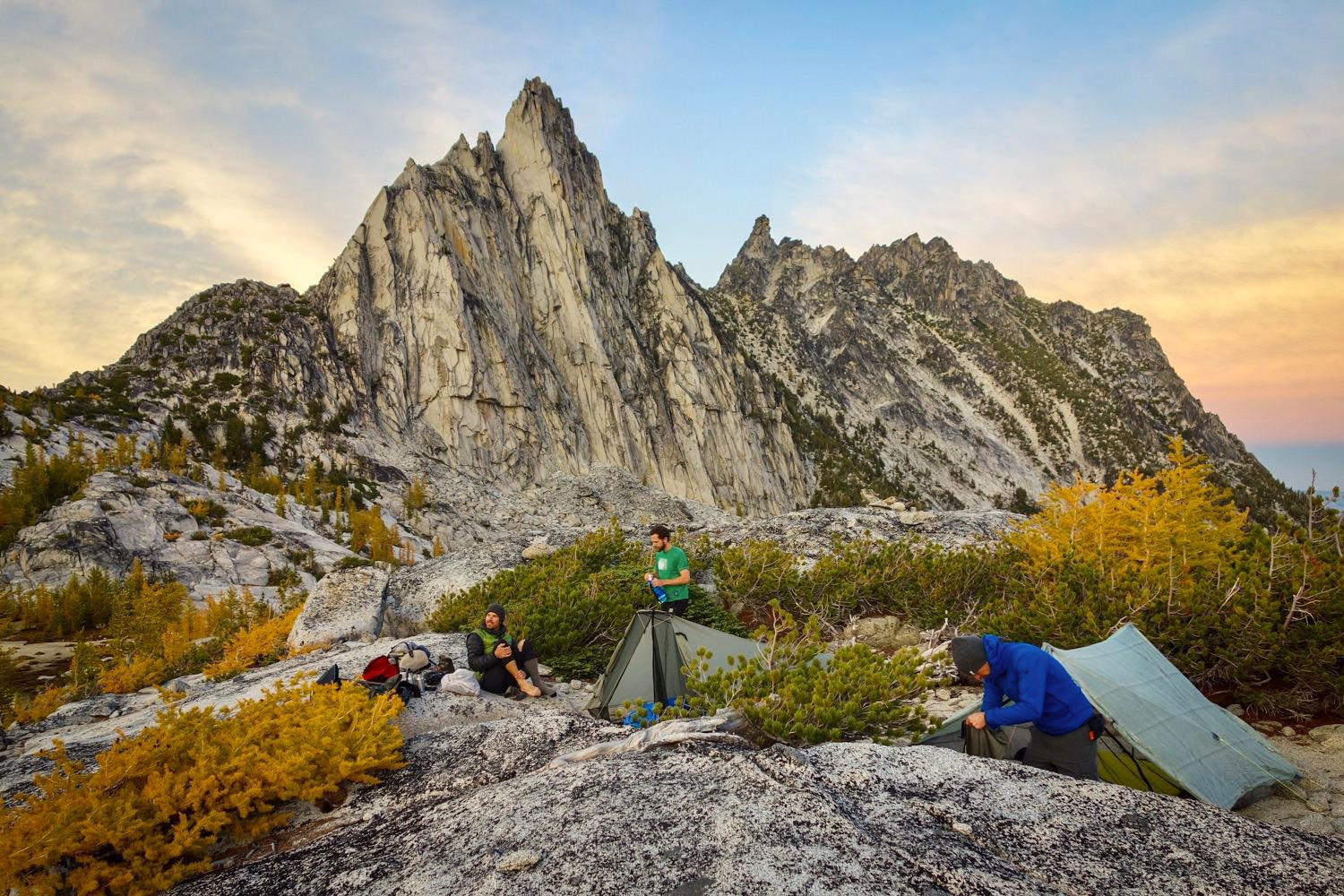
PRICE:
We’re typically willing to spend a bit more for a high-quality backpacking tent with a low packed weight because we truly believe that leads to more comfortable and enjoyable backcountry trips. Livability and weight tend to trump cost in our books, but we recommend quality options at a variety of price points in our list below.
- Best mid-range backpacking tents: Big Agnes Copper Spur HV UL 2, REI Flash 3, Big Agnes Tiger Wall UL2, SlingFin Portal, NEMO Hornet OSMO 3, MSR FreeLite 2, NEMO Dagger OSMO 2
- Best budget backpacking tents: REI Trailmade 2, REI Trail Hut 2, REI Half Dome SL 2+, Six Moon Designs Lunar Duo / Lunar Solo, REI Flash 2
- Best high-end backpacking tents: Big Agnes Copper Spur UL3, Sea to Summit Telos TR2, Zpacks Duplex / Triplex / Plex Solo
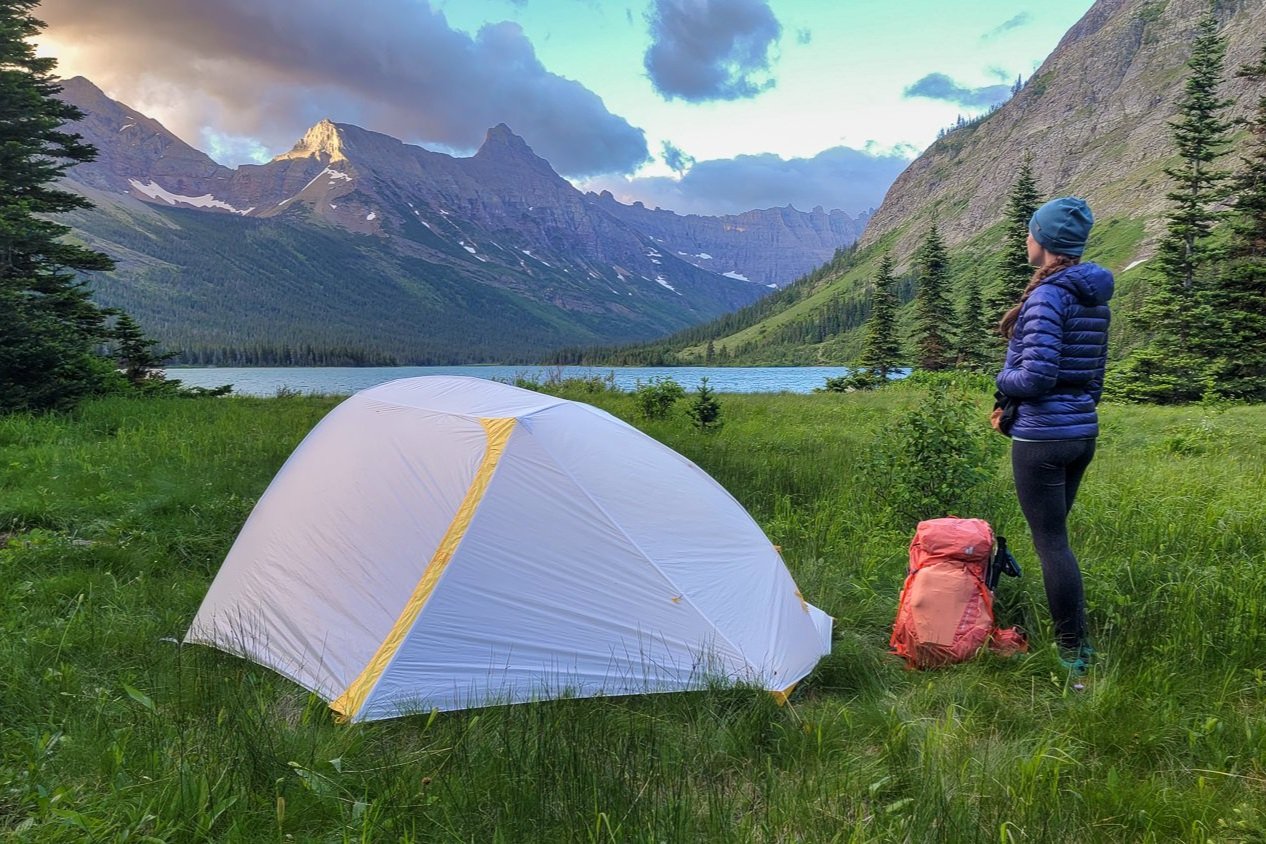
SPACE:
When choosing a backpacking tent, look for one with a good balance of space and weight. Many backpacking tents come in multiple size options (1P, 2P, etc.), but it’s very common for tents to feel smaller than their capacity ratings imply. If you plan to share your tent with another hiker, think about how comfortable you are with tight spaces and the width of your sleeping pads (many 2P backpacking tents won’t fit two wide pads).
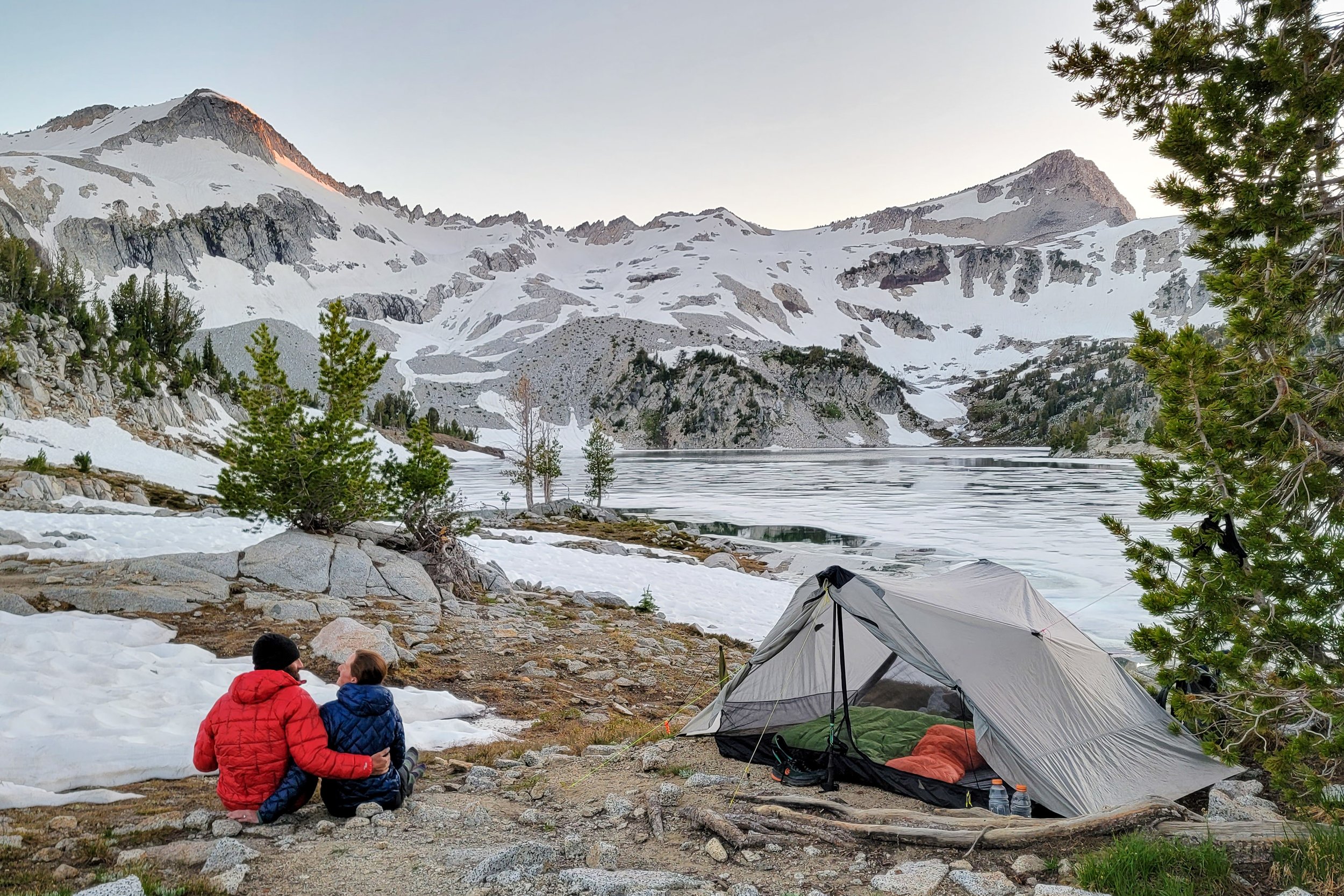
DURABILITY & WEATHER PROTECTION:
If you tend to be tough on gear or you often backpack in harsh, exposed conditions, picking up a more durable backpacking tent will likely be a smart choice. Small abrasions can easily be fixed, but all tents have their breaking points. If long-term durability is one of your top concerns, it may be beneficial to go with a tent that’s a bit more burly. Sturdier tents usually weigh more, but they’ll shed nasty weather easily and last a very long time.
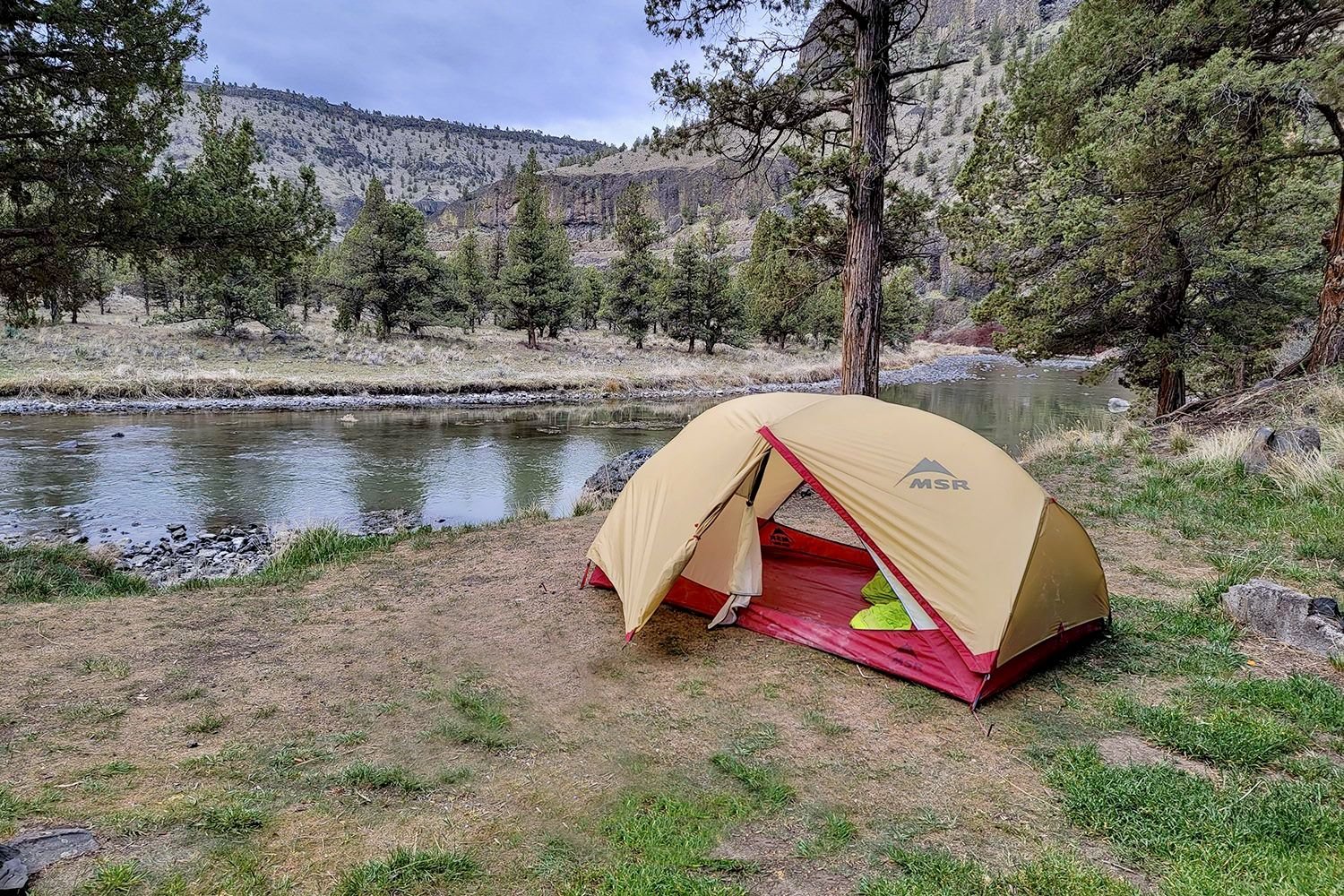
BEST 1-PERSON BACKPACKING TENTS:
Going with a 1-Person tent is an easy way for a solo hiker to drop a lot of bulk and weight out of their pack. However, some solo hikers prefer having more space and would be happier in a lightweight 2-person tent. You’ll need to decide which is more important to you: saving space and weight in your pack with a 1P tent or having more room and versatility with a 2P tent.
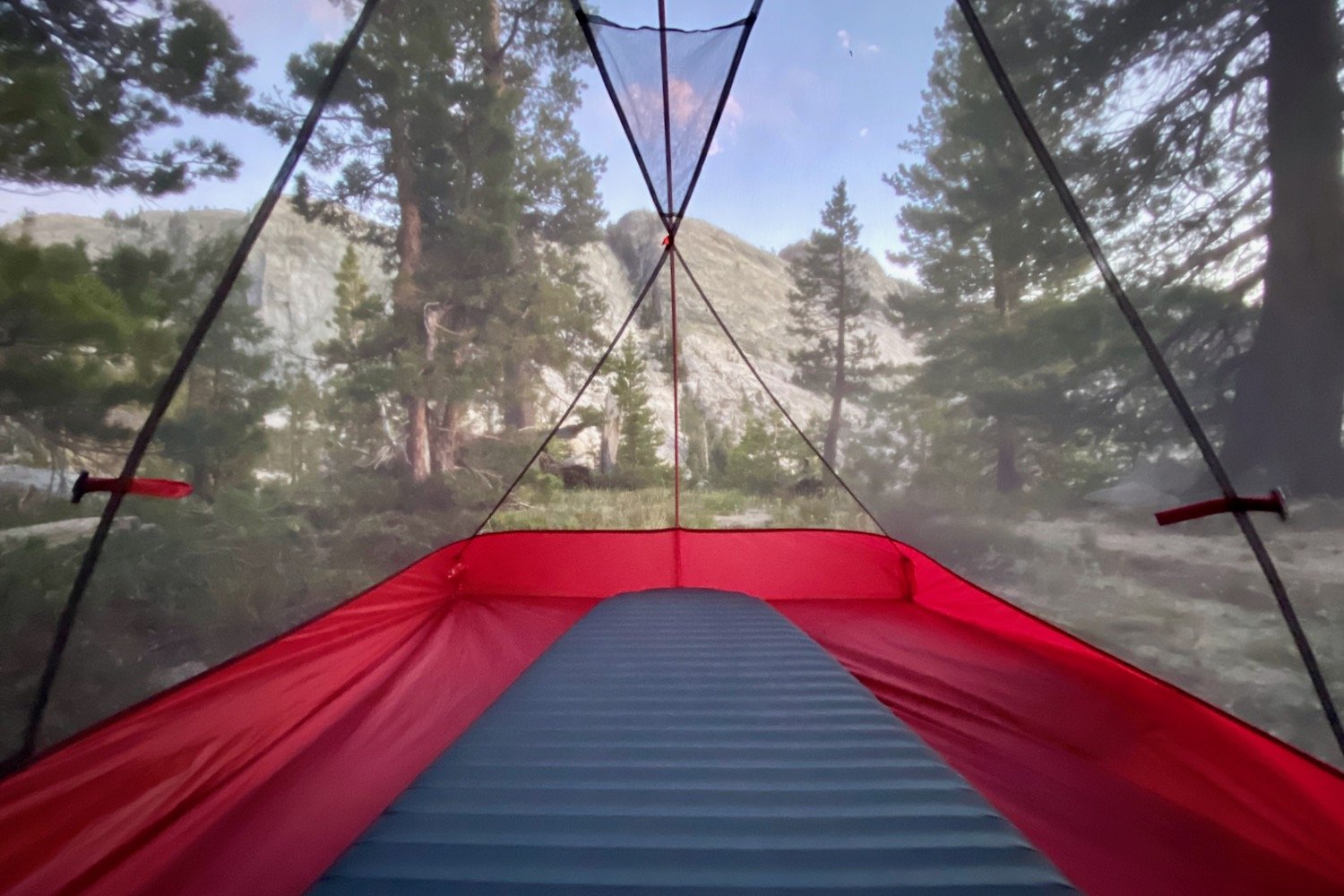
Best Backpacking Tents of 2023
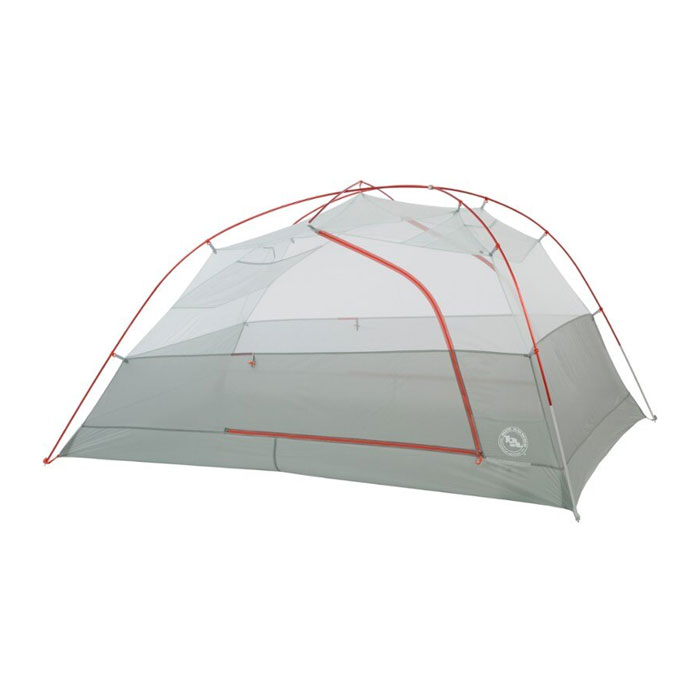
Big Agnes Copper Spur HV UL2 & UL3
Best backpacking tent overall for weight, space & quality
Price: MSRP (UL2): $550
Weight: (UL2): 3 lb. 2 oz.
Dimensions: 88 x 52/42 x 40 in. (wider at head, narrower at foot)
Pros
- Lightweight
- Freestanding
- Roomy interior
- Quick/easy to pitch
- Great pockets
- Large doors/vestibules
- Quality construction/materials
Cons
- Expensive
- Rainfly zippers can snag
The Copper Spur HV UL2 and UL3 are some of Big Agnes’ best-sellers, and they’re among our all-time favorite backpacking tents. The ultralight freestanding design of the Copper Spur enables hikers to pitch almost anywhere, and it doesn’t sacrifice convenience, weather protection, or livability.
The Copper Spur is a popular choice among thru-hikers of the AT, PCT, and CDT, all of which are notoriously tough on gear. If you take care to clear pokey debris from your campsites, this tent will last for thousands of miles. We’ve been backpacking with our Copper Spur 2 and 3 for several years and they’re still going strong.
The Copper Spur’s bent-pole structure and top crossbar create nearly vertical sidewalls providing a ton of usable interior space and ample headroom. The UL2 has enough space for two regular-width sleeping pads and some gear, while the UL3 is roomy enough for two wide pads and keeping all of your gear inside. Whichever size you go with, you’ll have a backpacking tent that provides an exceptional balance of camp comfort and weight.
For more, check out our full review of the Copper Spur HV UL2.
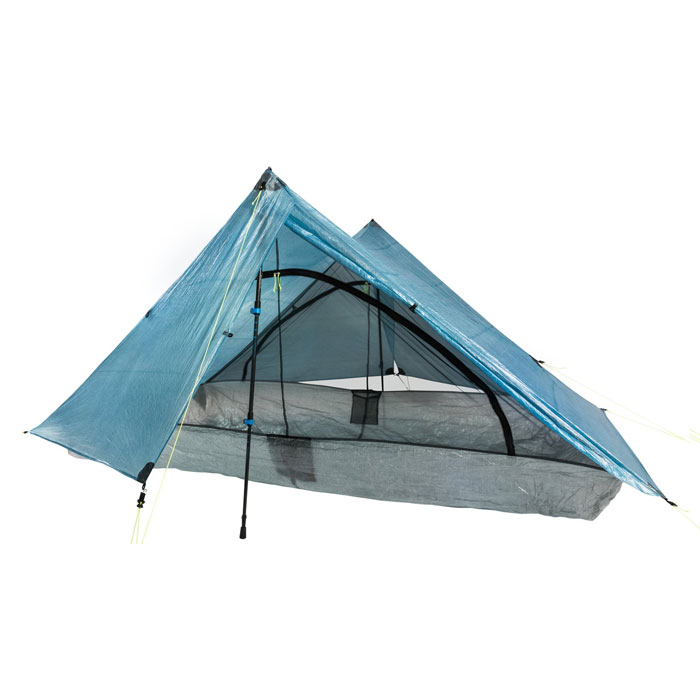
Zpacks Duplex, Triplex & Zpacks Plex Solo
Best ultralight backpacking tent
Price: (Duplex): $669
Weight: (Duplex): 1 lb. 2.5 oz. (no stakes or poles)
Dimensions: (L x W x H): 90 x 45 x 48 in.
Pros
- Ultralight
- Large doors/vestibules
- Roomy for two (Triplex)
- DCF material won’t sag when wet
- Durable
- Trekking poles can double as tent poles
Cons
- Expensive
- Condensation management necessary for single-wall tents
- Non-freestanding design has a learning curve
The Zpacks Duplex, Triplex, and Plex Solo are our go-to ultralight backpacking tents for thru-hiking and long-distance adventures. These tents provide an excellent amount of interior space and weather protection at a freakishly low weight.
The secret to these tents is the DCF material. It’s waterproof, tough, incredibly light, and doesn’t sag when wet; the downside is that it’s expensive. The Duplex, Triplex, and Plex Solo may be spendy, but they’re an incredible investment if you love to backpack as light as possible. The other key to the Plex’s ridiculously low weight is the non-freestanding, single-wall design. This eliminates the need for tent poles and a rainfly, but it may take a few pitches to get it perfect if you’ve never used a backpacking tent like this before.
The high ceiling of the Duplex/Triplex will allow you and your hiking partner to sit up comfortably at the same time, and the two-door design will keep you from crawling over each other to get in and out. If you’re looking for the best ultralight backpacking tent on the market, this is your guy.
We think the Duplex and Triplex are both spacious enough for two hikers. But since they’re so light, we’re partial to the Duplex for solo hikers who like to have extra interior space and the Triplex for more square footage when hiking with a partner. Solo hikers who prioritize saving weight above anything can’t go wrong with the Plex Solo.
For more, check out our full reviews of the Duplex, Triplex, and Plex Solo.
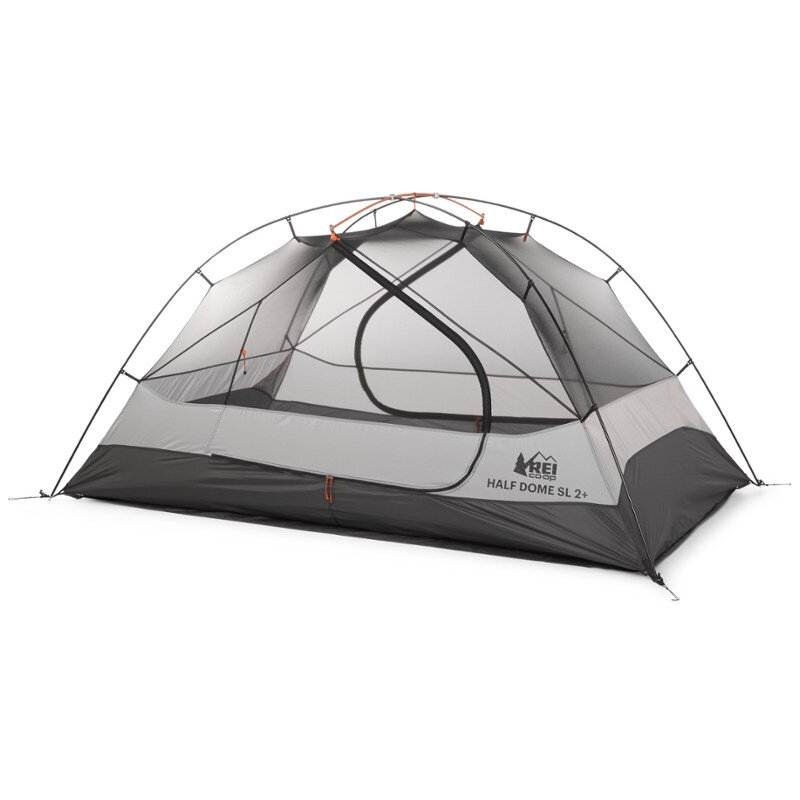
REI Half Dome SL 2+
Best budget crossover tent for backpacking & car camping
Price: MSRP: $329
Weight: 4 lb. 11.5 oz. (including footprint)
Dimensions: (L x W x H): 90 x 56 x 42 in.
Pros
- Affordable
- Very roomy interior
- Durable
- Quick/easy to pitch
- Freestanding
- Footprint included
Cons
- Heavier/bulkier than some
REI’s Half Dome SL 2+ has an exceptional balance of price, durability, and interior space. Its symmetrical freestanding design and very roomy dimensions make it comfortable and user-friendly for hikers of all experience levels. This tent is our favorite budget-friendly crossover choice for those who like camping in the frontcountry and the backcountry.
Though the weight of the Half Dome is more than we prefer for strenuous backpacking adventures, it’s not too bad when split between two hikers. In addition, you can save about 8 ounces by leaving the included footprint – a nice tent floor durability bonus – at home.
If a good balance of durability, convenience, interior space, and affordability is what you’re looking for, it’s very tough to beat the REI Half Dome SL 2+.
For more, check out our full review of the Half Dome SL 2+.
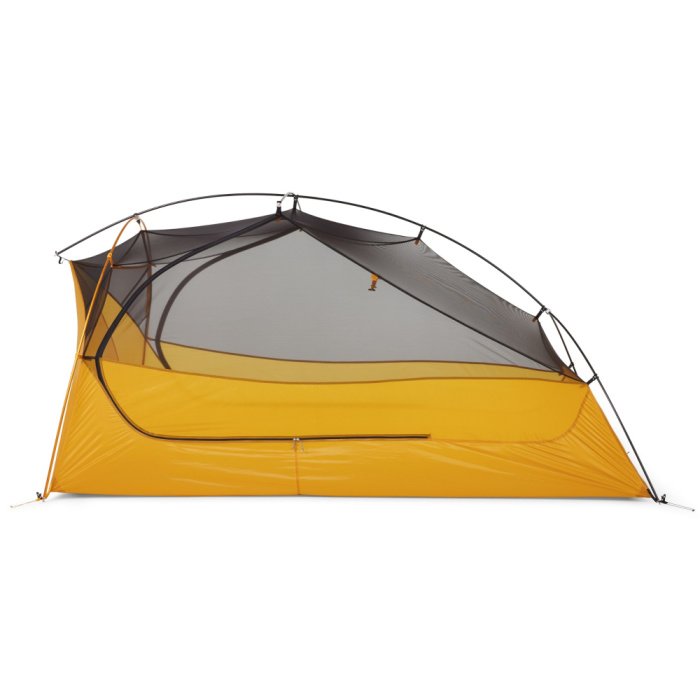
REI Flash 2 & Flash 3
Best budget freestanding ultralight tent
Price: (Flash 2): $399
Weight: (Flash 2): 3 lb. 4.2 oz.
Dimensions: (L x W x H): 88 x 52/42 x 40 in. (wider at head, narrower at foot)
Pros
- Affordable for the quality & weight
- lightweight
- freestanding
- roomy interior
- quick/easy to pitch
- good pockets
- large doors/vestibules
- quality construction/materials
REI has made some of our favorite tents over the years, but few have been as impressive as the Flash 2. This tent has a weight and interior volume that rival some of the most popular backpacking tents of all time, but it costs far less than anything in its class.
With its unique pole architecture, the Flash 2 manages to feel more spacious than tents with the exact same dimensions – like the Big Agnes Copper Spur 2. The headwall of the Flash 2 stands vertically and is supported by an arch pole that pulls the sidewalls out. As a result, you end up with more headroom where you need it most.
Like most tents that aim to cut down on weight as much as possible, the Flash 2 will need to be treated with care to extend its lifespan. We had a sharp pine needle work its way through the floor early on during testing. There’s no permanent damage to show for it, but it did drive home the need to really clear out a space to camp if you don’t plan to use a footprint. We always hike with a bit of Tenacious Tape to repair the inevitable snags and tears that come with use on trail.
We highly recommend the Flash 2 to hikers looking to save a significant amount of money without having to compromise on weight, space, or the convenience of a freestanding design. And those looking for even more space should check out the Flash 3, which still costs less than many of the two-person tents on our list and only weighs about 10 oz more than the Flash 2.
We’re putting this tent through more field-testing to determine its final position on this list. It has the potential to take over the top spot. Checkout our full review of the Flash 2 here.
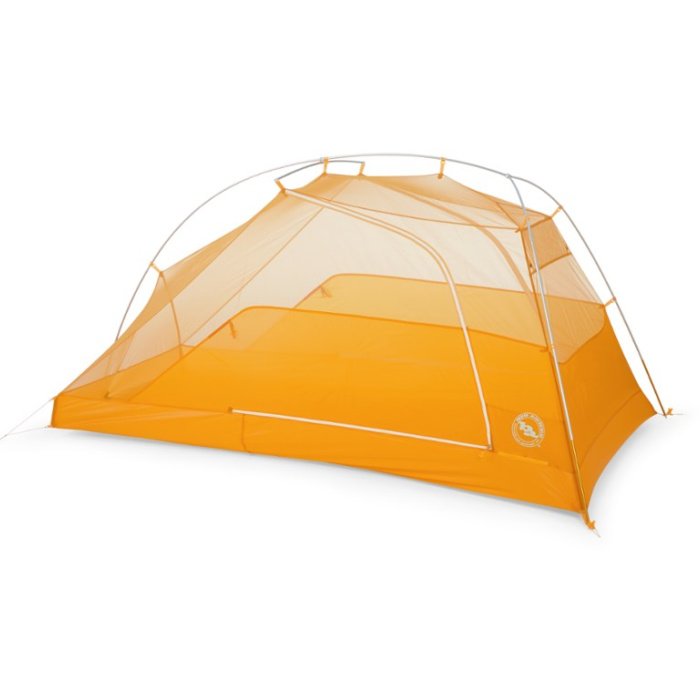
Big Agnes Tiger Wall 2
Best semi-freestanding tent
Price: MSRP: $450
Weight: 2 lb. 8 oz.
Dimensions: (L x W x H): 86 x 52/42 x 39 in. (wider at head, narrower at foot)
Pros
- Ultralight
- Convenient pockets
- High-quality hardware (smooth zippers & DAC poles)
- Roomy for one
- Two doors/vestibules (a perk for solo hikers)
Cons
- Tight for two
- Not as durable as some (floor material is thin)
- No rainfly vents
Ounce-counting hikers will love the ultralight, semi-freestanding design of the Big Agnes Tiger Wall 2. With enough structure to perform well in inclement weather, but a weight that’s barely over a pound when split between two hikers – the Tiger Wall is a more convenient alternative to non-freestanding ultralight tents.
Often semi-freestanding tents can feel a bit cramped. And while the quarters in the Tiger Wall are a bit tight, it has a wider ridge pole than most other tents of this style. This creates more livable space where you want it most – at the head when sitting up. Another feature that increases comfort in the Tiger Wall is the easy-to-use door toggles that give you the ability to roll back both sides of the vestibule for taking in grand views or maxing out ventilation on clear nights.
Overall, hikers who prioritize saving weight and don’t mind sharing a tighter space will love the minimal yet functional design of the Tiger Wall 2. If you prefer more room to spread out, the Tiger Wall 3 has extra floor space and a few more inches of peak height but is still lighter than many 2P tents. For more info, check out our full review of the Tiger Wall here.
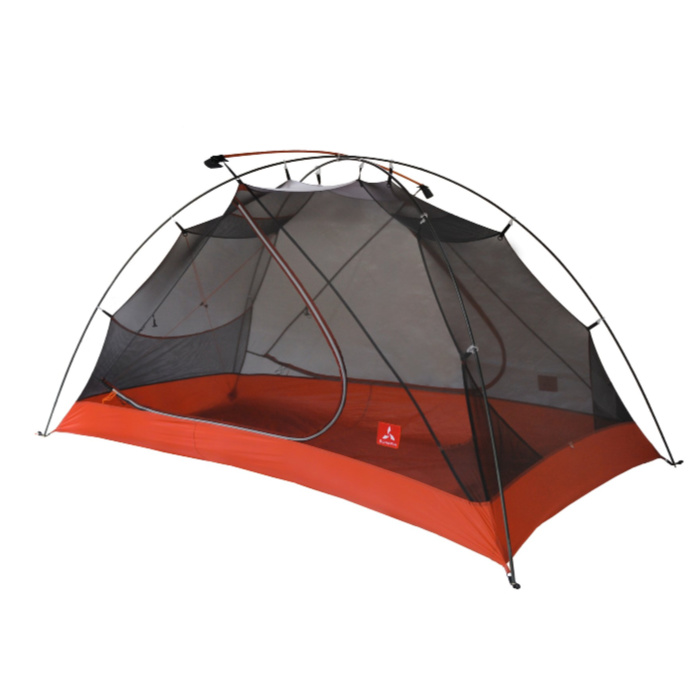
SlingFin Portal
Lightweight & sturdy tent with lots of headroom
Price: MSRP: $540
Weight: 3 lb. 5 oz.
Dimensions: (L x W x H): 85 x 51/42 x 44 in. (wider at head, narrower at foot)
Pros
- Excellent weather protection
- lightweight
- roomy interior
- quick/easy to pitch
- useful pockets
- large doors/vestibules
- quality construction/materials
- freestanding
Cons
- Expensive
- Rainfly zippers can snag
With an extra stable frame, maximized interior space, and top-quality construction/materials, the SlingFin Portal is an excellent shelter to hunker down in when nasty weather hits. Thicker poles, internal guylines, and the ability to attach trekking poles for added structural strength make the Portal extremely solid in wind, rain, and even light snow. These features are unique for a lightweight backpacking tent and are more common in high-end mountaineering shelters.
One of our favorite features of the Portal is its generous amount of headroom, which makes it feel much more livable than the average lightweight 2P backpacking tent. Other details, like great pockets and extra zipper sliders, come together with the storm-worthy design to make the Portal one of the best backpacking tents we’ve ever tested.
For more, check out our full review of the Portal.
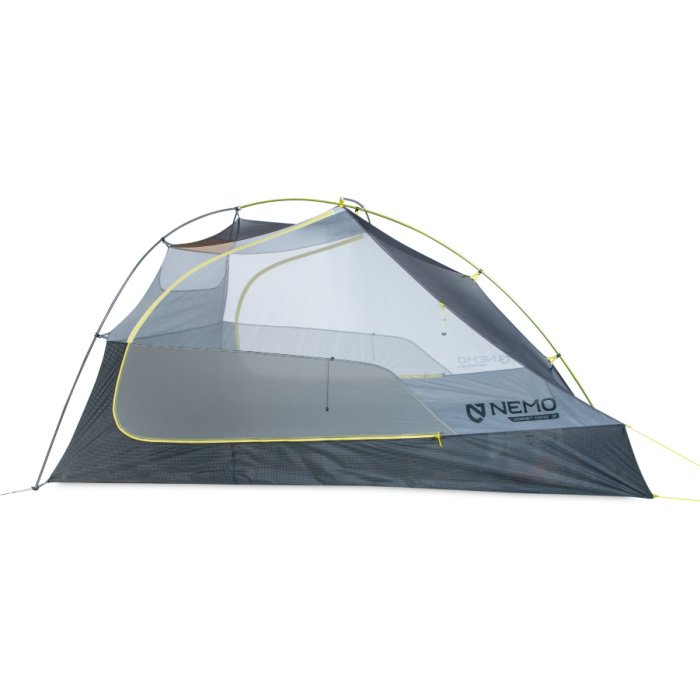
NEMO Hornet OSMO 3
Great value tent for UL hikers wanting more space
Price: MSRP: $550
Weight: 3 lb. 5 oz.
Dimensions: (L x W x H): 88 x 68/62 x 44 in. (wider at head, narrower at foot)
Pros
- Ultralight
- Well-priced for the specs
- Roomy for two
- Convenient pockets
- High-quality materials (sag-free fabric & smooth zippers)
- Good ventilation
Cons
- Rainfly zippers can snag
- Only one side of the rainfly can be tied back
Ultralight doesn’t have to mean sacrificing comfort. With the NEMO Hornet OSMO 3, a pair of hikers can have all the conveniences of a traditional 2-person tent – two doors/vestibules, a roomy interior, useful pockets – without the additional weight. As an added bonus, this spacious shelter costs around the same amount of money as many of the leading 2-person backpacking tents.
You might want extra space for a variety of reasons – maybe you want to fit two wide sleeping pads with room to spare, you travel with a large dog or an adventurous kid, or you just want a little more breathing room when sharing your tent with a partner. Whatever your reason may be, the generous floor dimensions and peak height of the Hornet 3 will accommodate.
Not too long ago, NEMO rolled out their proprietary OSMO fabric and began implementing it on all of their tents. OSMO fabric repels water better than standard nylon or polyester flysheets, and best of all – OSMO stretches far less when wet. This means your pitch stays taut during rain, and you won’t have to worry about saggy rainfly material causing wet spots on your tent body, sleeping bag footbox, or head.
We’ve always been big fans of NEMO’s attention to detail, high-quality construction, and innovative designs, and the Hornet OSMO 3 definitely doesn’t disappoint. For those who prioritize saving weight over having extra space, the NEMO Hornet OSMO 2 is also a great choice and is a bit more affordable than similarly designed tents.
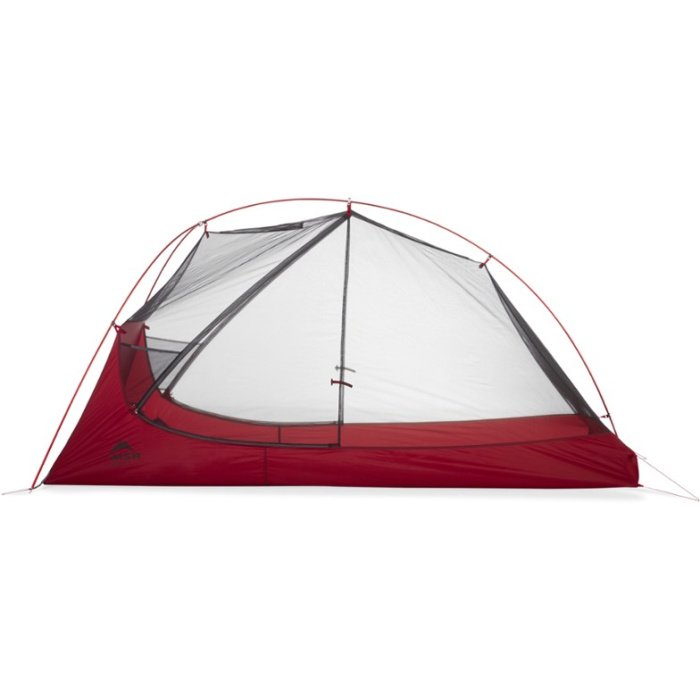
MSR FreeLite 2
Good balance of weight & livability for solo hikers
Price: MSRP: $450
Weight: 2 lb. 5 oz.
Dimensions: (L x W x H): 84 x 50 x 39 in.
Pros
- Ultralight
- roomy for one
- two doors/vestibules (a perk for solo hikers)
- convenient pockets
- rainfly gutter prevents drippy entry
The MSR FreeLite 2 is a great option for those looking to go lighter without sacrificing the convenience of a double-wall tent. It has two large doors/vestibules, and the interior space feels more roomy for two hikers at a much lower weight than other similarly designed tents.
We generally view the FreeLite as more comfortable for solo hikers since the interior headroom can feel a little cramped when spending any extended amount of time inside. But for pairs that value saving weight over having extra wiggle room, the FreeLite certainly has enough space to accommodate two.
The rainbow shape of the FreeLite is effective at shedding rain, and a few design details – like well-placed pockets and a rainfly gutter – make this tent particularly appealing. Any backpacker wanting the best mix of weight, livability, and weather protection will surely love the FreeLite.
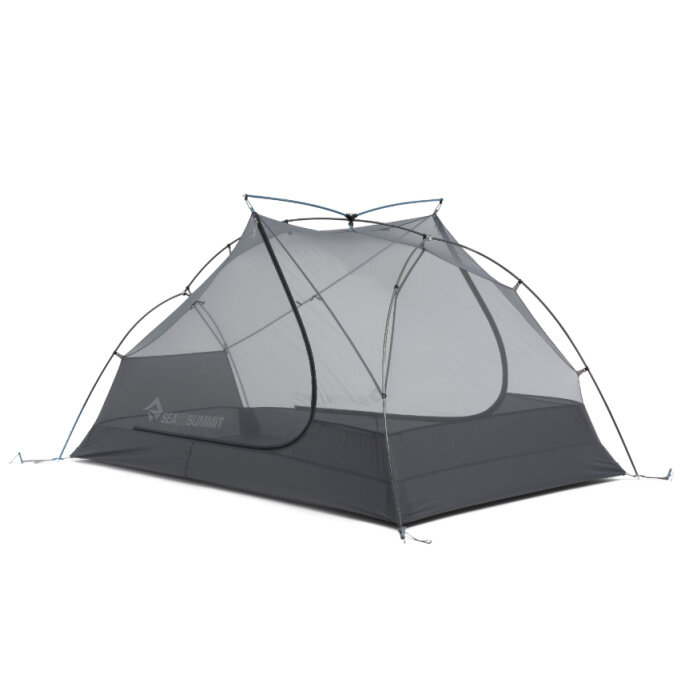
Sea to Summit Telos TR2
Exceptionally spacious tent with innovative features
Price: MSRP: $599
Weight: 3 lb. 10 oz.
Dimensions: (L x W x H): 84.5 x 53 x 43 in.
Pros
- Ample headroom
- Freestanding
- Lightweight
- Excellent ventilation
- Quick/easy to pitch
- Large doors/vestibules
Cons
- Expensive
- Heavier than some
The Sea to Summit Telos TR2 is an innovative tent with a lot of unique features to love. It has more headroom than any 2-person backpacking tent in its weight class, which makes it feel a lot more livable than many others.
Creature comforts, like the light-dispersing Lightbar and shady Hangout Mode, make the Telos feel like a little slice of luxury in the backcountry. Sea to Summit took extra care designing the adaptable ventilation on the Telos, and we found that it provided comfortable and practically condensation-free nights.
While it’s a little spendy, the comfort the Telos provides is worth the cost if you’re looking for a versatile 2-person backpacking tent with all of the details dialed in.
For more, check out our full review of the Telos TR2.
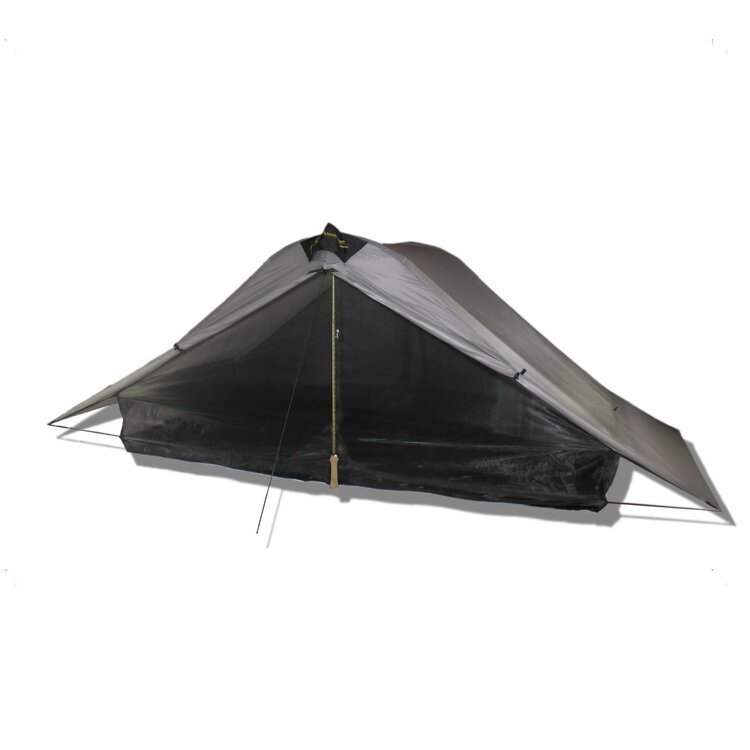
Six Moon Designs Lunar Duo & Solo
Affordable & spacious ultralight backpacking tents
Price: (DUO): $395
Weight: (DUO): 2 lb. 13 oz. (no stakes or poles)
Dimensions: (L x W x H): 90 x 54 x 45 in.
Pros
- Spacious
- affordable
- ultralight
- small packed size
- durable
- ample headroom
- excellent ventilation
- large doors/vestibules
Cons
- Seam sealing costs extra
- condensation management necessary for single-wall tents
- non-freestanding design has a learning curve
The Six Moon Designs Lunar Duo is one of the best value backpacking tents on our list due to its excellent blend of space, weight, and durability. We’ve put the Lunar Duo through the wringer on multiple thru-hikes, and it held up like a champ in all kinds of conditions.
It’s a bit heavier than some ultralight non-freestanding tents, but we find the weight tradeoff to be worth it for the significant monetary savings. One thing that makes the Lunar Duo unique is that the guylines can be re-tensioned from inside the tent, which is really convenient during a downpour. The large vestibules are designed to open completely without disturbing the structure of the tent, so you can have similar ventilation and view benefits of a double-wall tent.
If you’re looking for a roomy ultralight shelter at an exceptionally affordable price, there are few tents that come close to the Lunar Duo. For more, check out our full review of the Lunar Duo.
The Lunar Solo is one of our top picks for solo hikers. It’s very spacious for one person and their gear, is easy to set up, and packs down incredibly small. For more, check out our full review of the Lunar Solo.
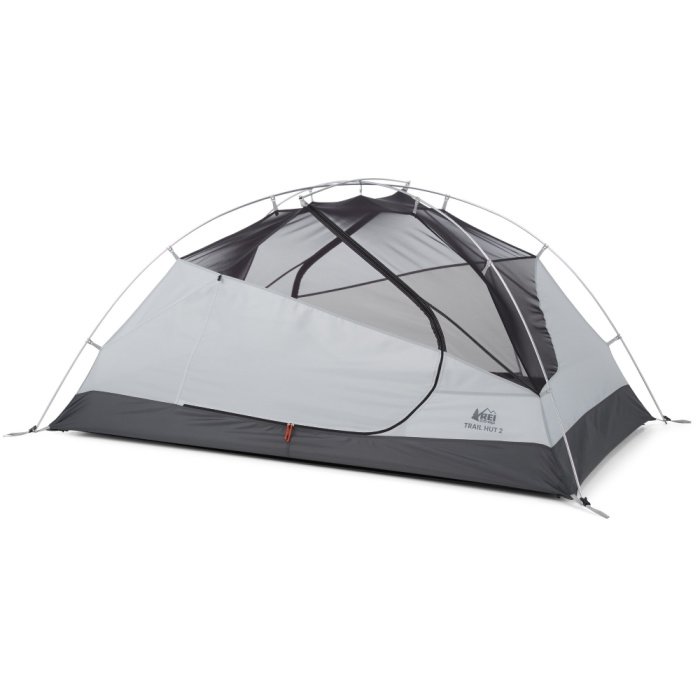
REI Trail Hut 2
Most affordable crossover tent for backpacking & car camping
Price: MSRP: $199
Weight: 5 lb. 15 oz. (including footprint)
Dimensions: (L x W x H): 88 x 52 x 40 in.
Pros
- Affordable
- durable
- freestanding
- large doors/vestibules
- strong zippers
- quick/easy to pitch
- footprint included
Cons
- Heavier/bulkier than some
The affordable REI Trail Hut 2 is an excellent tent for hikers on a tight budget or those wanting a crossover tent for car camping and backpacking. It’s quick and easy to pitch, made with durable materials, and the weight/bulk aren’t too bad when split between two hikers. You can also save about 8 ounces by leaving the included footprint at home.
While none of the Trail Hut’s specs or features (other than price) are really standouts, this tried-and-true design will hold up well in bad weather and keep you on the trail for hundreds – if not thousands – of miles.
The budget-friendly Trail Hut doesn’t skimp on interior space or quality, so we think it’s an excellent investment for those wanting to hit the trail without spending a fortune.
If you’re looking to go as affordable as possible, the REI Trailmade 2 costs less and is a bit lighter. Ultimately we prefer the Trail Hut for its larger interior space, but either tent is a solid choice.
For more, check out our full review of the Trailmade 2.
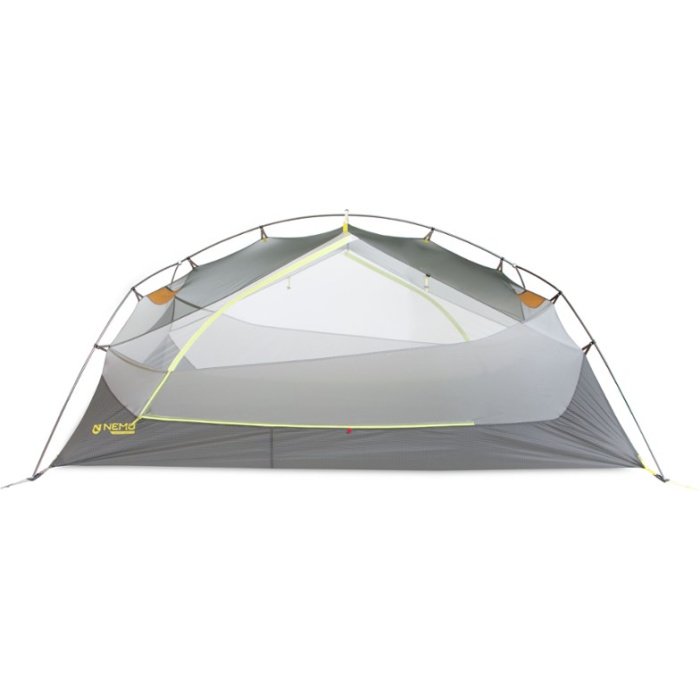
NEMO Dagger OSMO 2
Best crossover tent for backpacking & car camping
Price: MSRP: $530
Weight: 4 lb. 2 oz.
Dimensions: (L x W x H): 90 x 50 x 42 in.
Pros
- Very spacious
- Freestanding
- Quick/easy to pitch
- Versatile
- Large doors/vestibules
- Light for how much space it offers
- Durable
- Great pockets
Cons
- Heavier than some
- A bit expensive
The NEMO Dagger OSMO 2 offers a ton of interior space at a reasonable weight, so it’s perfect for those wanting a tent that’s comfortable for both backpacking and car camping.
The Dagger has a ton of convenient features built in, like two huge vestibules for gear storage, light-dispersing headlamp pockets, and an included tub accessory that keeps your gear clean and dry in the vestibule. The innovative OSMO fabric also doesn’t sag when wet like Silnylon and it will remain waterproof for longer than the coated fabrics used for many other tents.
If you’re looking for lightweight livability in a convenient design, the NEMO Dagger 2P is an excellent choice.
For more, check out our full review of the Dagger OSMO 2.
Honorable Mentions
The following backpacking tents didn’t make our final list, but they’ve still got a lot of good things going for them. You never know, one of these tents might be perfect for you:
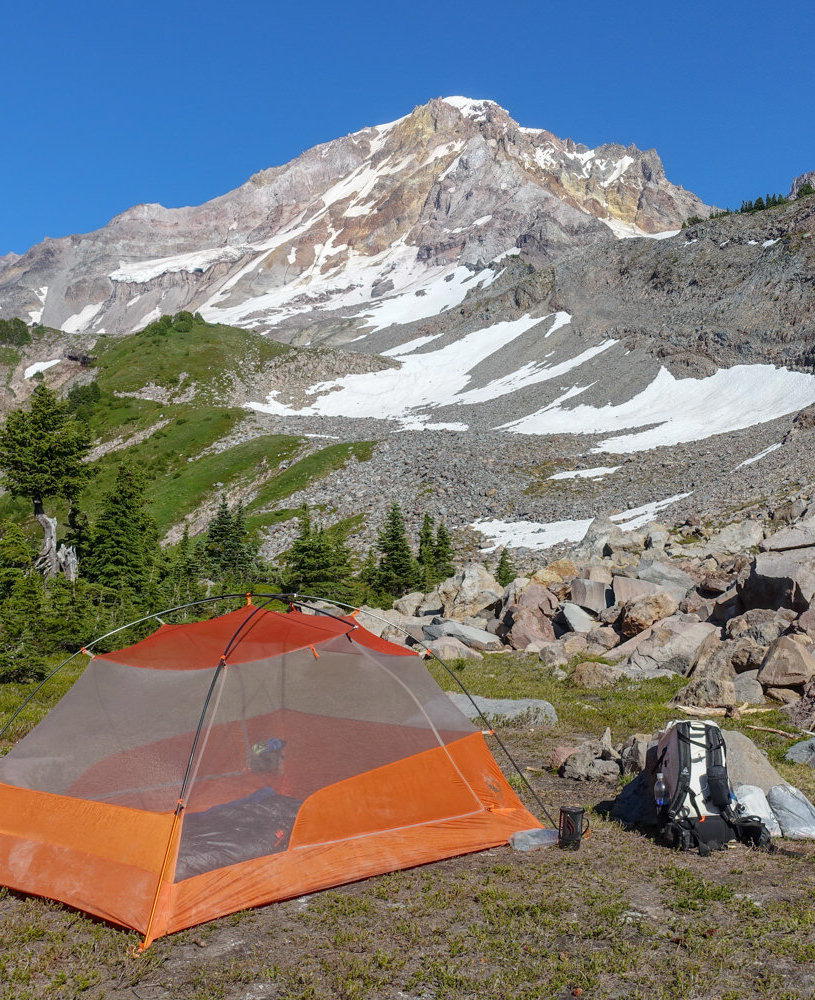
- MSR Hubba Hubba 2 – This tent stands out for its blend of low weight and weather protection. The Hubba’s symmetrical freestanding design makes it quick and easy to set up. But we find that the pole structure causes the walls to slope inward which limits interior headroom quite a bit. Check out our full review of the MSR Hubba Hubba 2 to learn more about the pros and cons.
- NEMO Dragonfly 2 – This tent is a little tight for two, but it’s a roomy option for solo hikers. It has two doors, two large vestibules, and a very small packed size. The Dragonfly has a freestanding design that’s easy to set up and performs a bit better in foul weather than the semi-freestanding Hornet on our main list.
- Tarptent Double Rainbow – The Double Rainbow has one of the best price to weight ratios of any backpacking tent on the market, but it also has some significant downsides. Its single-wall (hybrid) design makes it susceptible to interior condensation, and the interior space isn’t as comfortable for two. While the rainbow shape sheds rain effectively, it also cuts out a considerable amount of headroom.
- Big Agnes Fly Creek HV UL2 – This tent is among the lightest double-wall, semi-freestanding tents on the market. It has a similar floor plan to the MSR FreeLite (both actually work best as 1-person tents in our opinion), but the Fly Creek only has one door and vestibule which limits its livability. If a tent is only going to feature one door, we far prefer a side-entry over the front entry of the Fly Creek.
- Hilleberg Anjan 3 – If you commonly camp above treeline in harsh, exposed conditions, the Hilleberg Anjan could be a good option. We recommend choosing the 3-person model over the Anjan 2 for the extra space at a minimal cost/weight increase. This tent does have several key downsides though – only 1 door/vestibule, non-freestanding design, and a steep price tag.
Critical Tent Considerations
PRICE
You shouldn’t have to spend a fortune to get a great backpacking tent. That’s why this list contains an array of solid options at a variety of price points. If you backpack a lot, it probably makes sense to spend more for a quality product that will get many years of use. If you’re on a limited budget, you may want to check out our budget backpacking tent recommendations, but they do tend to be much heavier.
CHOOSING A SIZE
The reality with tent sizes is that a lot of manufacturers exaggerate how many people can sleep comfortably in them. For example, many two-person backpacking tents are a tight fit for two average-sized people. If you plan on sleeping two people in your tent and want more space, you may find a three-person tent to be more comfortable. Extra space will add weight, so you’ll probably want to choose a lightweight tent to keep your backpack light. Check out our Tent Size Guide for more info on finding the right fit for you.
When researching tents, you’ll likely notice a few different specs listed for weight and it can get a little confusing.
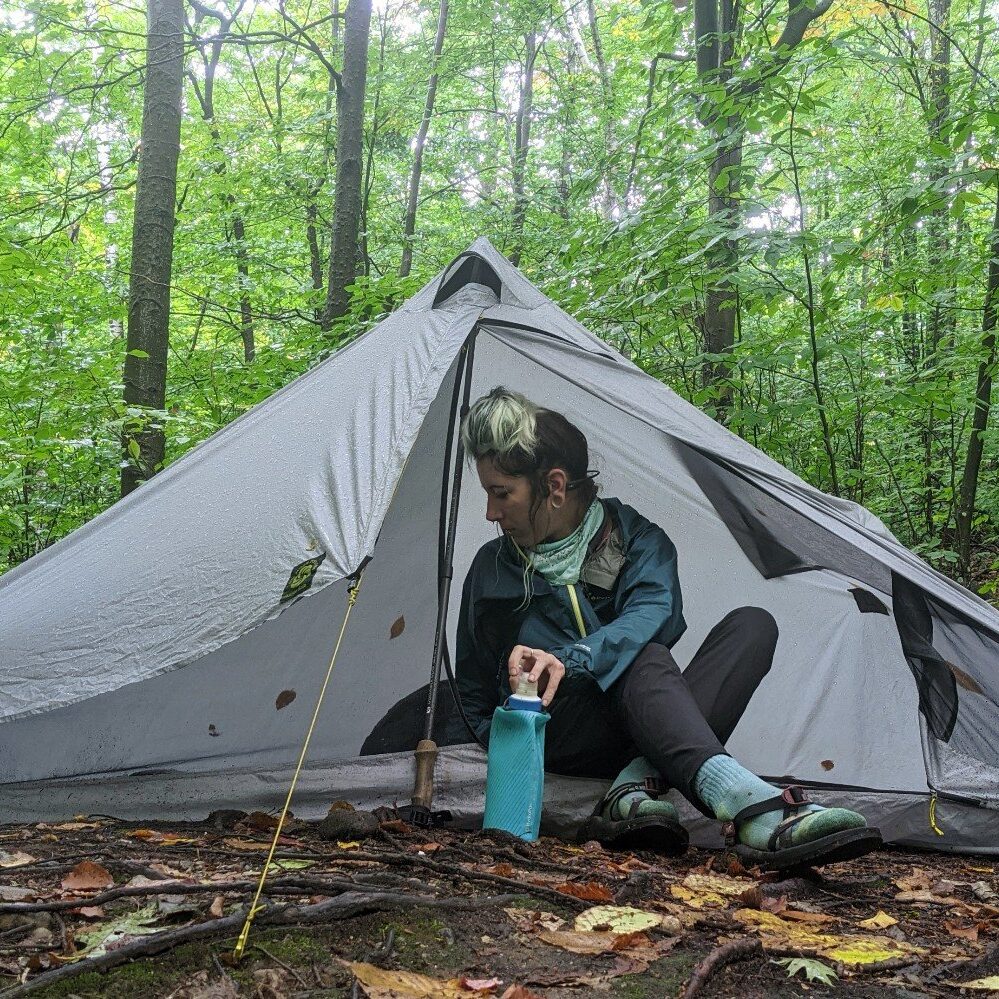
PACKAGED WEIGHT VS. MINIMUM TRAIL WEIGHT
When researching tents, you’ll likely notice a few different specs listed for weight and it can get a little confusing. Some manufacturers may even exaggerate how light a tent is to make it seem more appealing. Unfortunately, there is no required set standard for measuring backpacking tent weights across the industry, but here are some tips to help you decipher all the numbers:
- Packaged Weight – This spec refers to the weight of all parts of the tent plus any accessories it comes with when you buy it. This is usually the most accurate measurement to consider, and it’s the spec we’ve listed with all the tents on this list. After all, you’re going to be using tent stakes with your tent, right?
- Minimum Trail Weight – This one gets a little hairy. Since there’s no required industry standard for calculating this, some manufacturers exclude more items than others. Minimum trail weight is generally accepted to mean just the essential components to keep you dry. It will always include the tent body, the rainfly, and the poles. This measurement usually excludes tent stakes (unless your tent is semi-freestanding), guy lines, and stuff sacks.
MINIMUM TRAIL WEIGHT
This one gets a little hairy. Since there’s no required industry standard for calculating this, some manufacturers exclude more items than others. Minimum trail weight is generally accepted to mean just the essential components to keep you dry. It will always include the tent body, the rainfly, and the poles. This measurement usually excludes tent stakes (unless your tent is semi-freestanding), guy lines, and stuff sacks.
DO YOU NEED A FOOTPRINT?
Almost every backpacking tent on this list comes with the option to buy a footprint that will help extend the life of your tent floor. Footprints are not necessary, though, and many choose not to use them. It’s totally a personal choice, but a footprint will ensure that your tent floor lasts as long as possible. If you need help deciding if a footprint is right for you, check out our post Do You Really Need a Footprint for Your Tent.
PROTECTION
A backpacking tent that doesn’t protect against the elements is worse than worthless, it’s dangerous. So be careful about extreme budget tents you’ll find elsewhere. Every tent on this list will provide excellent storm protection to keep you safe, dry, and warm.
INTERIOR SPACE
Backpacking tents keep weight to a minimum by limiting interior space (and thus, use less material). One-person tents are great for dedicated solo hikers looking to travel fast and light. Two-person tents tend to be the most popular, because they strike a good balance between weight and interior space. Most two-person tents have just enough room for two sleepers and a few stuff sacks, with backpacks and extra gear stored in the vestibules. If you want more interior space for camping comfort, you may want to bump up one size in tents (for example, buy a three-person tent to fit two hikers). Just remember, interior tent space is a tradeoff between comfort and weight. Check out our Tent Size Guide for more information on choosing which model to go with.
SEASON RATING
Three-season shelters are the most popular backpacking tents and the style we’re focusing on in this guide. They’re built for spring, summer, and fall trips where you’ll need to keep bad weather out while promoting ventilation, which helps keep interior condensation to a minimum. Three-season tents can usually handle a little snow, but they’re not made for heavy snow and harsh winter conditions.
SETUP
Freestanding tents are generally preferable because they’re easier to use and quicker to pitch. They come with a fixed pole system that can be set up almost anywhere – even on solid rock. Non-freestanding tents use stakes, guylines, and trekking poles for pitching. They save weight by cutting out tent poles, but require more time/space to pitch and will take more practice to master.
DOORS & VESTIBULES
If you plan on sleeping two people in your tent, it’s more comfortable to have two doors and two vestibules. Having separate entrances will ensure that you’re not climbing over a tentmate and two sets of gear every time you want to get in or out of your tent. That’s a huge benefit, and it’s why almost all of our backpacking tent recommendations have two doors and vestibules.
WALL CONSTRUCTION
Double-wall tents come with two separate parts – a mesh tent body and a rainfly. The mesh inner-tent acts as a barrier from condensation that forms on the inside of the rainfly. Single-wall tents reduce weight by attaching the fly sheet directly to the mesh inner-tent, but that leaves hikers vulnerable to interior condensation in wet/cold conditions. Rubbing up against a wet tent interior is the pits, so we mostly recommend double-wall tents unless you usually backpack in arid, dry climates. For ultralight hikers open to the idea of single-wall shelters, have a look at our Best Ultralight Tents list.
DURABILITY
The main trade-off with lightweight backpacking tents is that they’re built using thinner materials, which tend to be less durable than heavy-duty shelters. That said, ultralight tents will literally last for thousands of miles if treated with care. It’s also important to remember that a sharp stick or rock will puncture just about any kind of tent fabric. If you’re tough on gear and don’t want to deal with lightweight materials, we recommend choosing one of our heavier recommendations built for durability or adding a footprint to to increase the durability of your tent floor. For our personal use, we think lightweight tents are well worth the tradeoff.
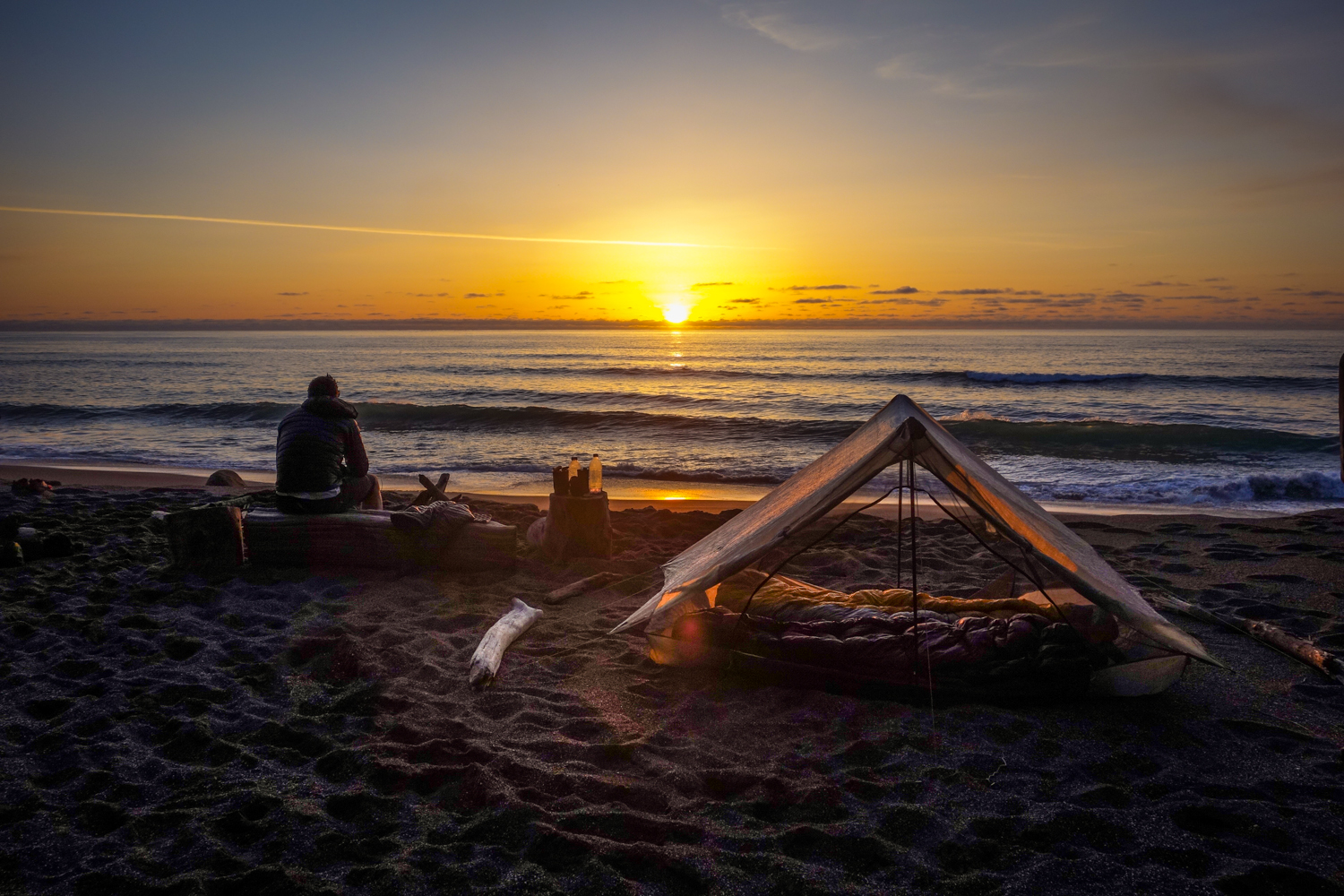
More Information
We hope this guide helps you find the perfect gear for your needs. If you have more questions or a suggestion, we’d love to hear from you! Sign up for our newsletter to stay updated on our latest posts then visit our Facebook page and Instagram to join the community conversation.
If you found this guide helpful, please share on social media and click the little heart button below to give us a digital high five! Also, be sure to check out our CleverHiker Gear Guide to see all of our top gear picks.
Thanks for reading and happy trails!
